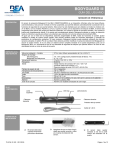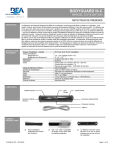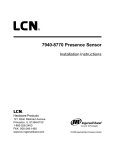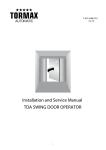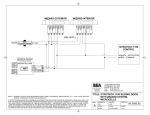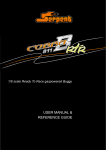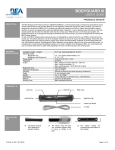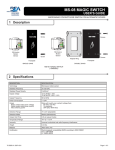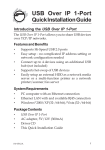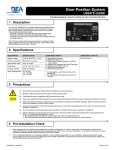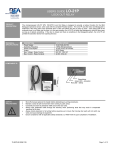Download BEA BODYGUARD III GT 400 User's Manual
Transcript
BODYGUARD III QUICK SETUP GUIDE PRESENCE SENSOR FOR PEDESTRIAN DOORS 1 Description The Bodyguard III Quick Setup Guide is for the installation and setup of the Bodyguard III. This document is provided for experienced installers, service personnel & AAADM Certified Inspectors that are familiar with the Bodyguard III. For those who are not completely familiar with the installation and setup of the Bodyguard III, BEA recommends following the detailed installation and setup instructions found in the Bodyguard III User’s Guide (75.5134). Bodyguard performance shall be adjusted and in compliance with all applicable current safety standards (ANSI A156.10). 2 Installation 1. The Bodyguard shall be mounted near flush with the bottom of the automatic door header on the swing side. This is absolutely necessary to allow the Bodyguard detection pattern to reach back through the threshold area when the door is in the open position. If any portion of the door face or related hardware on the swing side project beyond the Bodyguard face, a Bodymount must be installed in conjunction with the Bodyguard. 2. The Bodyguard should be mounted at a height range of 6’ 6” to 8’ (Max. of 9’). 3. The Bodyguard should be center mounted up above on the header and flush with the bottom of the automatic door header. This is absolutely necessary to allow the detection pattern to reach back through the threshold area with the Bodyguard is in the open door position. SINGLE DOOR APPLICATIONS - The Bodyguard should be mounted overhead at the center of the door opening. However, if this is not possible, the unit may be installed off-center. In such cases, pattern location will have to be altered for proper placement of the field of detection. Try to avoid mounting locations that may pose potential problems such as directly over a door arm. DOUBLE-EGRESS APPLICATIONS - One Bodyguard shall be mounted overhead on the header over each swing-path. There should be at least 40” of separation between the 2 Bodyguards when measured between the centerline of each sensor. Most double egress applications are knowing act. Ensure compliance with current ANSI 156.10-2005 Section 9.2. Most double egress installations will require IR frequency and/or open door pattern depth adjustments. Change IR frequency of one Bodyguard to 3 and the other to 4 (See Tech Bulletin #32 or Bodyguard User Guide 75.5134 for more explicit information regarding double egress applications with respect to location and setting up the Bodyguard. 3 Wiring Use the cable that is provided for use with the 10-pin connector as shown or wire the 7-pin terminal block. If wiring the Bodyguard to a BEA module (i.e. LO LINX or a version of the LO-21), refer to the wiring diagrams for the respective module. For ease of installation, wire the terminal before attaching it to the Bodyguard. POS 1 2 3 4 5 6 7 WIRE COLOR (10-Pin Cable) 12 to 24 VAC/VDC +/- 10% Red 12 to 24 VAC/VDC +/- 10% Black COM White NO Green NC Data Brown Data + Blue CONNECTION (7-Pin) RED BLACK WHITE GREEEN BROWN BLUE 1 PWR 2 PWR 3 COM 4 NO 5 NC 6 IN 7 IN + 10 PIN PCB NOTE: Never short the data wires when power is applied as this will destroy the lockout. 4 Mechanical Adjustment 5° Default Angle 1. Aside from placement on the header, the only mechanical adjustment that may be made to the sensor is the angle adjustment. The Bodyguard is factory pre-set to the +5° position, but may be reduced to a 0° position or increased to a 10° position. The greater the angle, the farther from the door the pattern will be. The 0° angle should only be used when the Bodyguard is mounted to a Bodymount block or to a soffit above the door that extends out from the face of the swing side of the door (in this case, the 0° setting would improve the location of the detection field across the threshold area of the doorway). It is recommended that for most applications, the unit be powered and walk tested at the pre-set 5° angle. After walk testing, if the detection field needs to be changed, then proceed with changes as explained next. 2. To change the angle setting the end caps, lenses, center eye shield and terminal block if it has been wired must be removed. Once removed, release the white clips and rotate outward to remove the PCB. Once the PCB is completely removed from the housing, the angle position may be changed. There are two clips per Bodyguard and the angle must match for each clip on the PCB. ANGLE ADJUSTMENT CLIP (WHITE) 5 Setup 1. Upon completion of mechanical and electrical installation, apply 12 to 24 VAC/VDC +/- 10% to the Bodyguard with the door in the closed position. The Bodyguard will flash a green LED at a rate of 2 Hz, then it will expire upon a successful set-up in the door closed position. NOTE: If applying the Bodyguard to a door control that requires a learn cycle upon powering, it is recommended to allow the doors to complete a learn cycle before applying power to the Bodyguard. 2. Activate the door to the full open position. When using BEA’s lockout relay, the Bodyguard will once again flash the green LED and will execute a door-open set-up. Upon completion of the set-up for the door-open position, the doors will begin closing. Normal operation should resume thereafter. Proceed with fine-tuning to insure compliance with all current applicable safety standards (i.e. ANSI A 156.10). If set-up is unsuccessful, refer to the Troubleshooting Guide at the end of the Bodyguard User’s Guide (75.5134) and also to the guide located at the end of the respective lockout User’s Guide. HELPFUL HINT: After set-up and to confirm the correct motor polarity to the lockout, the correct data and data polarity and to ensure the lockout is communicating properly to the Bodyguard. Activate the door open and perform a door open set-up with the remote by pressing Unlock, Magic Wand, #2. If the Bodyguard flashes green continue with final tune in. If not, refer to Bodyguard User Guide (75.5134). The most likely cause is the motor lead polarity is reversed at the lockout or data polarity is reversed at Bodyguard. 75.5362.01 20090210 Page 1 of 2 Pattern Width, Depth & Sensitivity all have independent door closed and door open values. 6 Sensing Zone Adjustment Pattern Depth Pattern Width (Open / Closed) 1: Wide (CLOSED DOOR) 2: Middle (OPEN DOOR) 3: Asymmetric Left Narrow 4: Asymmetric Right Narrow 5: Narrow Left 6: Narrow Right 1: Deep (Threshold ON) 2: Medium (Threshold ON - OPEN) 3: Limited (Threshold ON) 4: Deep (Threshold OFF) 5: Medium (Threshold OFF - CLOSED) 6: Limited (Threshold OFF) 7: Asymmetric Left Wide 8: Asymmetric Right Wide 9: Center Narrow 1ST ROW OF IR THRESHOLD 1ST ROW OF IR 2ND ROW OF IR THRESHOLD 3RD ROW OF IR 4TH ROW OF IR 1 2 3 4 5 7 8 2ND ROW OF IR 1 2 6 3 4 9 5 6 3RD ROW OF IR 4TH ROW OF IR NOTE: When pattern width or depth is changed, a setup of the new pattern size will automatically be triggered once a value key has been pressed. 7 Configurations ENSURE COMPLIANCE WITH ALL APPLICABLE CURRENT SAFETY STANDARDS (I.E. ANSI A156.10). BUTTON VALUE PARAMETER BUTTON VALUE PARAMETER SENSITIVITY Door Closed = 6 Door Open = 7 0 (min) 9 (max) INTERFACE New Style Old Style (LO21, B, K, P, S, U, LO-LINX, MC15) AUTO LEARN 0 = 30 sec 9 = Infinite 0 (min) 9 (max) SETUP / WAND Door Closed = 1 Door Open = 2 Restore to Default OUTPUT CONFIG. NO NC IMMUNITY Low (Normal) Medium (Rain) High (Snow) * * - BGIII-C 1 2 9 HOLD TIME 0 = 0.5 sec 9 = 9 sec 1 2 0 (min) 9 (max) FREQUENCY Normal Mode; Low Normal Mode; High Quiet Mode; Low Quiet Mode; High 1 2 3* 1 2 1 2 3 4 8 Door Control Connections SWING SWING ACT COM SAF STILL HUNTER ACT RTN SAF 1 SAF 2 RTN KM K Green White Red Yellow White Grey STANLEY L Orange Yellow Red Blue Yellow ACT COM SAF STALL STALL COM Besam 300 13 12 11 15, 17 16, 18 Besam M/P 3 4 9 5 13 Yellow Grey Blue Purple DOM GT 300/400 GT MAG HORTON 4190 STALL COM Black Red White White Red STANLEY M/P 2 1, 8 7 7 1, 8 6 Black 5 Red 4 White 3 Violet 5 Red STANLEY 521 TB4-5 TB4-4 TB4-8 TB4-10 TB4-9 2 3, 6, 8 4 10 3, 6, 8 TORMAX TDA 2 1, 3, 6, 8 8&9 7 1, 3, 6, 8 9 Company Contact Do not leave problems unresolved. If a satisfactory solution cannot be achieved after troubleshooting a problem, please call BEA, Inc. If you must wait for the following workday to call BEA., leave the door inoperable until satisfactory repairs can be made. Never sacrifice the safe operation of the automatic door or gate for an incomplete solution. The following numbers can be called 24 hours a day, 7 days a week. For more information, visit www.beasensors.com. US and Canada: Canada: Northeast: 1-866-249-7937 1-866-836-1863 1-866-836-1863 Southeast: Midwest: West: Page 2 of 2 1-800-407-4545 1-888-308-8843 1-888-419-2564 75.5362.01 20090210


